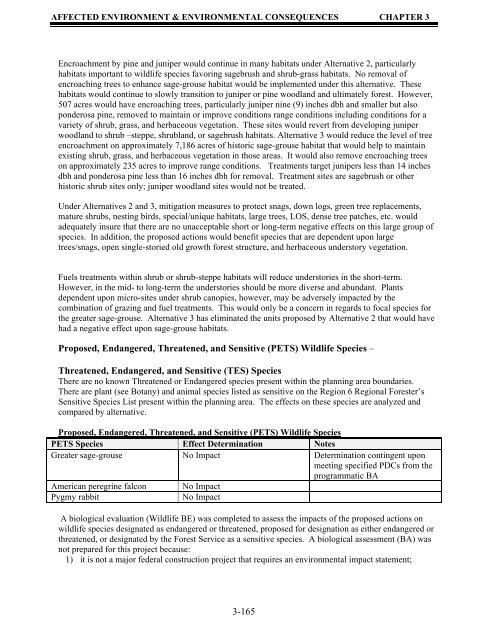Environmental Assessment
Environmental Assessment
Environmental Assessment
Create successful ePaper yourself
Turn your PDF publications into a flip-book with our unique Google optimized e-Paper software.
AFFECTED ENVIRONMENT & ENVIRONMENTAL CONSEQUENCES CHAPTER 3<br />
Encroachment by pine and juniper would continue in many habitats under Alternative 2, particularly<br />
habitats important to wildlife species favoring sagebrush and shrub-grass habitats. No removal of<br />
encroaching trees to enhance sage-grouse habitat would be implemented under this alternative. These<br />
habitats would continue to slowly transition to juniper or pine woodland and ultimately forest. However,<br />
507 acres would have encroaching trees, particularly juniper nine (9) inches dbh and smaller but also<br />
ponderosa pine, removed to maintain or improve conditions range conditions including conditions for a<br />
variety of shrub, grass, and herbaceous vegetation. These sites would revert from developing juniper<br />
woodland to shrub –steppe, shrubland, or sagebrush habitats. Alternative 3 would reduce the level of tree<br />
encroachment on approximately 7,186 acres of historic sage-grouse habitat that would help to maintain<br />
existing shrub, grass, and herbaceous vegetation in those areas. It would also remove encroaching trees<br />
on approximately 235 acres to improve range conditions. Treatments target junipers less than 14 inches<br />
dbh and ponderosa pine less than 16 inches dbh for removal. Treatment sites are sagebrush or other<br />
historic shrub sites only; juniper woodland sites would not be treated.<br />
Under Alternatives 2 and 3, mitigation measures to protect snags, down logs, green tree replacements,<br />
mature shrubs, nesting birds, special/unique habitats, large trees, LOS, dense tree patches, etc. would<br />
adequately insure that there are no unacceptable short or long-term negative effects on this large group of<br />
species. In addition, the proposed actions would benefit species that are dependent upon large<br />
trees/snags, open single-storied old growth forest structure, and herbaceous understory vegetation.<br />
Fuels treatments within shrub or shrub-steppe habitats will reduce understories in the short-term.<br />
However, in the mid- to long-term the understories should be more diverse and abundant. Plants<br />
dependent upon micro-sites under shrub canopies, however, may be adversely impacted by the<br />
combination of grazing and fuel treatments. This would only be a concern in regards to focal species for<br />
the greater sage-grouse. Alternative 3 has eliminated the units proposed by Alternative 2 that would have<br />
had a negative effect upon sage-grouse habitats.<br />
Proposed, Endangered, Threatened, and Sensitive (PETS) Wildlife Species –<br />
Threatened, Endangered, and Sensitive (TES) Species<br />
There are no known Threatened or Endangered species present within the planning area boundaries.<br />
There are plant (see Botany) and animal species listed as sensitive on the Region 6 Regional Forester’s<br />
Sensitive Species List present within the planning area. The effects on these species are analyzed and<br />
compared by alternative.<br />
Proposed, Endangered, Threatened, and Sensitive (PETS) Wildlife Species<br />
PETS Species Effect Determination Notes<br />
Greater sage-grouse No Impact Determination contingent upon<br />
meeting specified PDCs from the<br />
programmatic BA<br />
American peregrine falcon No Impact<br />
Pygmy rabbit No Impact<br />
A biological evaluation (Wildlife BE) was completed to assess the impacts of the proposed actions on<br />
wildlife species designated as endangered or threatened, proposed for designation as either endangered or<br />
threatened, or designated by the Forest Service as a sensitive species. A biological assessment (BA) was<br />
not prepared for this project because:<br />
1) it is not a major federal construction project that requires an environmental impact statement;<br />
3-165
















